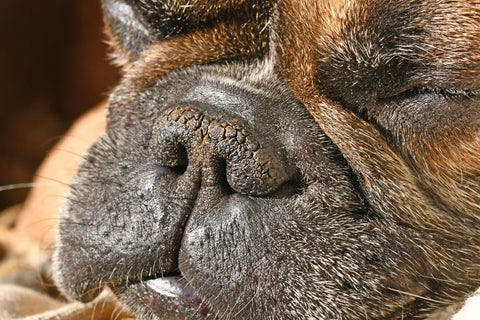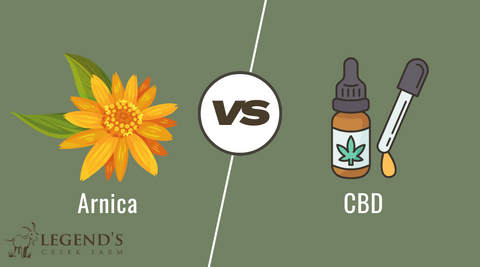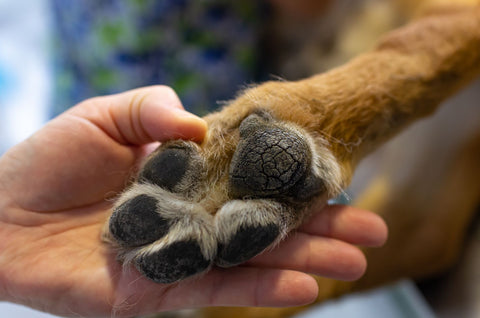A dog’s nose can become dry and cracked due to dehydration, aging, weather, blocked tear ducts, hyperkeratosis, or autoimmune issues. Most cases are mild and treatable with hydration, nose balm, and gentle skincare. Persistent symptoms may need veterinary care.
Your dog’s nose is a vital tool for sniffing, regulating temperature, and staying healthy. So when it turns dry or cracked, it’s natural to worry. Fortunately, many causes are manageable at home with the right care.
Dry Dog Nose (At a Glance)
-
Just Woke Up: Dogs often wake with dry noses, moisture returns within 15 minutes.
-
Environmental Dryness: Cold air, AC, or indoor heat can dry out the nose.
-
Aging: Older dogs produce less natural moisture.
-
Blocked Tear Ducts: Causes one-sided dryness that doesn’t go away.
-
Hyperkeratosis: Thick, crusty buildup from excess keratin.
-
Dehydration or Panting: Heat, exercise, or excitement pulls moisture from the nose.
-
Fever or Infection: Cracking + behavior changes may signal illness.
Quick Relief Tip: Apply a pea-sized dab of Legend’s Creek Farm Nose Balm before walks or nap time to protect and heal.
What a Dry, Cracked Nose Means for Your Dog
When a dog’s nose goes from moist to dry and cracked, it often catches people off guard.
Some shrug it off as cosmetic. Others worry it points to something more serious.
The truth is somewhere in between. Dry noses are often manageable, but they can also be the first visible sign of discomfort or internal imbalance. Knowing what to watch for and when to act can make a big difference in how your dog feels and functions.
How Common Is It?
Dry noses are more frequent than most dog owners realize.
Older dogs tend to experience it more often due to changes in skin function and reduced natural moisture. Breeds with short snouts or flatter faces are also affected, partly because they cannot easily lick their noses.
Seasonal shifts, especially during cold winters or dry summers, often bring on short-term dryness that goes away with better hydration or indoor humidity.
For many dogs, it is a recurring condition rather than a one-time issue.
Can It Become Serious?
Most cases of dryness resolve with simple care, but some progress into deeper cracks or scabs.
When the skin splits or bleeds, it can open the door to infection. Dogs might also paw at their noses or avoid eating if the area becomes sore.
In some cases, a cracked nose is one part of a larger medical issue such as an immune-related skin disorder or an endocrine problem like hypothyroidism.
These conditions need medical treatment and are often missed in the early stages. If the nose changes color, develops crusts, or comes with signs like lethargy or weight changes, a vet visit is the next step.
Why It’s a Problem
A dry or cracked nose can cause more than just surface irritation. It affects how your dog experiences the world and responds to daily routines.
Moisture on the nose helps with scent detection and even plays a part in temperature control. When that barrier breaks down, your dog might not act like themselves. Over time, a damaged nose can lead to changes in behavior and comfort.
Some of the most noticeable effects include:
-
Less interest in sniffing or exploring
-
Pulling away from food due to discomfort when eating
-
Scratching or pawing at the nose, which can make cracks worse
-
Reduced ability to track scents or detect familiar smells
-
General signs of agitation or withdrawal from normal routines
These changes can be subtle at first but may build up if the dryness is not addressed. Even when the cause is mild, the impact on daily life can be frustrating for both the dog and the owner.
What Causes a Dog’s Nose to Dry Out?
A dry or cracked nose might seem like a random issue, but it usually traces back to a specific cause.
Some triggers are mild and temporary, while others may point to an underlying health concern. For many dogs, it is a combination of environmental stress and changes in the body.
Identifying the reason behind the dryness is the first step toward the right kind of care. Each of the causes listed below plays a role in how your dog’s nose looks and feels.
While not every case needs medical attention, knowing when to act helps prevent small issues from becoming more serious.
#1 Sleep and Rest
Dogs often wake up with dry noses. This is especially true for pups who sleep deeply or nap in warm areas. During sleep, dogs do not lick their noses, which means moisture is no longer replenished.
As a result, the nose can feel warm, rough, or even a bit flaky.
This change is usually short-lived.
Most dogs regain their normal moisture level within fifteen minutes of waking. If the dryness fades quickly and does not show signs of cracking or bleeding, there is no cause for concern. It is simply part of the body’s resting state.
#2 Environmental Dryness
Indoor air can become very dry during winter, especially when heating systems are running around the clock. Air conditioning has a similar effect in warmer months.
This low-humidity environment draws moisture from exposed skin, including the sensitive surface of the nose. Dogs who spend time outdoors in windy, sunny, or cold weather may also develop dryness or chapping. Even brief exposure to pavement heat or dry wind can affect skin balance.
These conditions do not always cause long-term harm but can lead to irritation if repeated often. Environmental dryness is one of the most common causes of a rough or flaky nose.
#3 Aging
As dogs get older, their skin and glands begin to change.
One natural shift involves a drop in nasal mucus production. The moisture that once kept the nose soft and cool becomes less consistent. This makes senior dogs more prone to dry patches or cracking, even if they have no other symptoms.
While this does not always require medical treatment, it may call for regular skincare support. Moisturizing at the right times and keeping an eye on skin condition can help older dogs stay comfortable as they age.
#4 Dehydration or Excitement
Dogs lose moisture during periods of high activity, whether from running, playing, or reacting to new situations. Excitement often leads to panting, which reduces the amount of saliva and moisture available to keep the nose wet.
If your dog’s nose feels dry after a walk or training session, it may simply be the result of this moisture loss. The same is true during hot weather or after long car rides.
Dehydration can happen faster than many pet parents expect. Offering water frequently and keeping an eye on skin texture helps manage this issue.
#5 Blocked Tear Ducts
Not every dry nose is caused by a skin problem. In some dogs, dryness appears only on one side of the nose. This can happen when the tear ducts are blocked.
Normally, tear fluid drains through these small ducts and into the nasal passages, keeping the inside and outside of the nose moist.
When a blockage occurs, that flow is disrupted. The nose on that side may become visibly dry or irritated. This issue is often missed because it seems like a minor change. If the dryness appears localized and does not go away, it is worth having your vet check for tear duct problems.
#6 Hyperkeratosis
Hyperkeratosis is a skin condition where the body produces too much keratin, the protein that forms the outer layer of skin. This excess buildup causes the nose to become thick, crusty, and sometimes cracked.
Dogs with this condition may show raised ridges or dry scales around the edges of the nose.
It is more common in older dogs and in certain breeds with genetic sensitivity to skin imbalance. While it may look painful, hyperkeratosis is manageable with regular care.
Soothing treatments and softening agents help reduce the buildup and bring relief.
#7 Fever or Infection
A dry or cracked nose can also signal a systemic issue. If your dog seems lethargic, refuses food, or shows changes in breathing, the dry nose may be part of a bigger picture.
Fever and infection often reduce moisture in the body. As a result, the skin becomes dry, and the nose may start to crack or bleed.
These symptoms should never be ignored.
A nose that shows sudden changes, especially alongside other health shifts, may require immediate care.
Your vet can run tests to find the cause and recommend a treatment plan based on what is going on internally.
Soothing Solutions for the Snout
Once you identify that your dog’s nose is dry or cracked, the next step is choosing a safe and effective solution. Not every case needs a trip to the vet, and in many situations, daily care at home brings noticeable relief.
Here are the most reliable ways to care for your dog’s dry nose.
Hydration First
Water is the most overlooked remedy for dry noses. Even mild dehydration changes the texture of a dog’s skin. During play, walks, or warm weather, dogs can lose moisture faster than expected.
If your dog’s nose feels dry after activity or rest, offer clean water and allow time for the body to recover.
Some dogs also need help drinking more during colder months when thirst signals become weaker.
Placing water bowls in different parts of the house and refreshing them often can make a big difference. Hydration should always be the first step in addressing skin dryness.
Use a Dog-Safe Nose Balm
Topical balm provides a layer of moisture that protects the nose and prevents further cracking.
Products made specifically for dogs are formulated to be gentle and safe if licked. The best options are free of added fragrance and artificial preservatives.
Ingredients like calendula, lanolin, and natural oils help soothe dry patches and soften thickened skin. Unlike human skincare, dog-safe balms do not contain zinc or other additives that can be harmful if ingested.
Adjust Indoor Humidity
Many dry nose issues begin during seasonal shifts when indoor air loses moisture. Heating systems in winter and air conditioning in summer both contribute to this change.
A dry home environment pulls moisture from the skin and nasal tissue, even when dogs are not outdoors.
Using a humidifier can help correct this imbalance. Placing it near your dog’s sleeping area is often enough to restore comfort during rest and recovery.
This adjustment is especially helpful for older dogs or breeds that are already prone to dryness.
Nutritional Support
A healthy nose starts with a balanced diet. Skin-friendly nutrients like omega-3 fatty acids and vitamin A improve your dog’s ability to retain moisture.
These nutrients support the body’s natural oil production and strengthen the skin’s outer layer. Some dogs benefit from added supplements, while others do well with whole-food sources such as fish or egg yolks.
Always introduce dietary changes gradually and check for signs of intolerance.
Combined with external care, the right nutrition builds long-term protection against dryness and helps restore a smooth, resilient nose.
Treat Your Dog with the Right Nose Balm
Caring for your dog’s skin should not involve guessing or compromising on safety.
That is why every Legend’s Creek Farm product is made with care, using gentle, effective ingredients that are free from synthetic fillers and known irritants. All formulas are cruelty-free and tested for safety.
For dogs dealing with dryness, cracking, or irritation on the nose, our products offer a safe and reliable way to restore comfort and moisture without risk.
Our Nose Balm is a great example. It hydrates dry skin, softens crusty spots, and supports healing with ingredients that are safe even if licked. There are no fragrances or additives that cause stinging or reaction. The balm is smooth, non-greasy, and works well for dogs of all sizes.
For those looking for more complete care, we also offer two bundles designed specifically for dog owners. The Nose and Paw Bundle includes our Nose Balm plus a nourishing Paw Balm to keep rough pads soft and comfortable year-round.
For a broader solution, the Total Pet Bundle includes both balms along with a gentle pet soap, giving your dog a full-body care routine that works together to reduce dryness and support skin health.
How to Apply Nose Balm
Using a balm correctly is just as important as choosing the right one.
Applying it the wrong way or at the wrong time can reduce its benefits and make it harder to stick with a routine. Dogs are sensitive to changes in scent and texture, so a calm, consistent approach makes the process easier for both of you.
When to Apply
The best time to apply balm is when your dog is calm or distracted.
After meals is ideal because most dogs are relaxed and less interested in licking. Nap time is another good window, especially for younger or high-energy dogs who are more likely to fidget when awake.
During the colder months, it also helps to apply balm right before going outside.
This creates a protective layer that shields the skin from cold wind and dry air. You do not need to apply it all day, just when the skin feels rough or begins to flake.
How Much to Use
Less is more. A pea-sized amount is usually enough for the entire nose.
Start by warming the balm between your fingers so it spreads evenly.
Gently press it onto the dry or cracked areas without rubbing too hard.
The goal is to create a light, even coat that softens the skin and locks in moisture. If the nose looks greasy or your dog tries to wipe it off, you may have used too much.
Tips for Lick-Prone Dogs
Some dogs try to remove anything new on their skin. If your dog tends to lick the balm off, try the following:
-
Apply during nap time or quiet rest
-
Offer a chew toy or treat right after application
-
Use gentle brushing or massage to distract
-
Sit with your dog for a few minutes while the balm absorbs
-
Try applying in a low-stimulation environment like a closed room
With patience and routine, even the most curious pups get used to nose balm and learn to leave it alone long enough for it to work.
Your Best Friend Deserves Natural Care
A dry or cracked nose may not seem urgent at first, but it can affect how your dog eats, plays, and explores. Small changes in texture or color can point to issues that are easy to manage with the right approach.
What matters most is paying attention and choosing care that supports your dog’s comfort without harsh ingredients. Natural solutions make a big difference when they are made for pets, not people.
Show your pup the same care they show you.
Visit our Pet Care Collection to find gentle, effective products made just for dogs.





